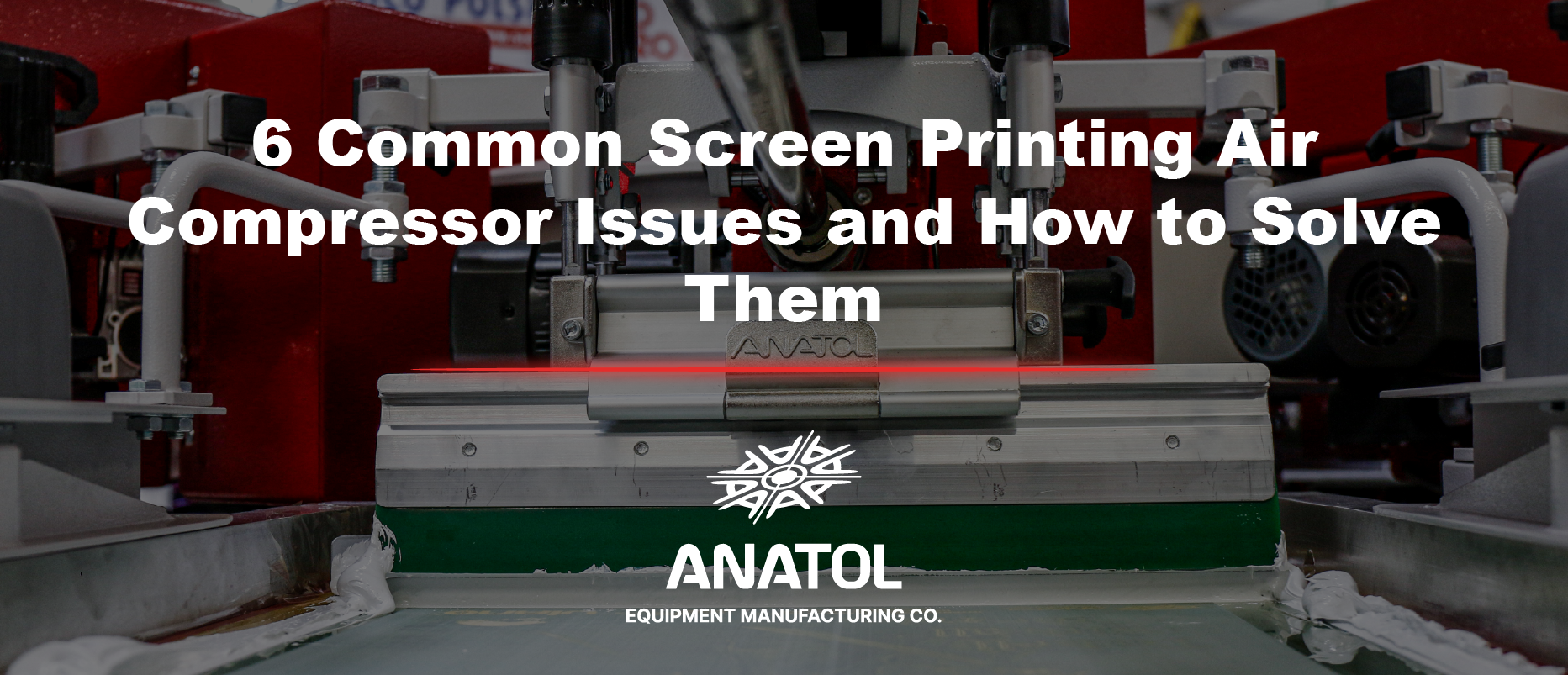

Революция в индустрии трафаретной печати благодаря передовым технологиям и качественному обслуживанию
Anatol Equipment Manufacturing Co.
1429 S Shields Dr
Waukegan, IL 60085


Революция в индустрии трафаретной печати благодаря передовым технологиям и качественному обслуживанию
Anatol Equipment Manufacturing Co.
1429 S Shields Dr
Waukegan, IL 60085

Air compressors and pneumatic systems are essential for many screen printing shops. They power automatic presses and other equipment to keep production efficient. However, issues such as low air pressure, moisture buildup, and air leaks can interrupt your work, reduce print quality, and increase maintenance costs. In this guide, we will review six common air compressor issues in screen printing, offer practical solutions, and introduce an innovative alternative: the electric screen printing press, Anatol VOLT.
Low air pressure is a frequent challenge when dealing with pneumatic screen printing problems. If your press does not maintain a steady 90–125 PSI, it may move slowly, have uneven squeegee pressure, or shut down unexpectedly, which slows production.
These issues can lead to costly production delays and reprints, while troubleshooting and resolving the problem may require labor hours and potentially expensive service calls.
Compressed air naturally contains moisture. This moisture can build up in air lines, causing corrosion, rust, broken parts, and ink problems when condensation drips onto screens. These are common issues with screen printing air compressors.
Over time, moisture damage can shorten the life of air-powered components and require costly replacements or repairs, in addition to ruining prints and wasting materials.
Air leaks in pneumatic systems cause energy waste and reduce how well machines work, leading to problems in screen printing. Even small leaks can cause problems and reduce efficiency.
Persistent leaks increase energy costs significantly and can lead to premature wear of your compressor, resulting in expensive repairs or even total system replacement.
Many air compressors use oil for lubrication. However, oil can get into the air lines, damaging pneumatic parts and affecting print quality. This is a common problem in screen printing maintenance.
Contaminated air can damage cylinders and valves, leading to costly downtime, while ruined prints may result in lost orders and wasted ink, mesh, and substrates.
When you overwork or fail to ventilate an air compressor properly, it overheats. This leads to unexpected shutdowns that stop production and worsen screen printing air compressor problems.
Each shutdown not only interrupts production but may also require costly emergency repairs or even replacement of burnt-out components, adding to operational expenses.
Pneumatic cylinders in automatic presses rely on compressed air to function. Worn or misaligned parts can lead to poor print quality and worsen other pneumatic printing issues.
Cylinder failure can stop press operation altogether and may require costly replacements, while degraded performance can result in flawed prints and wasted materials.
Pneumatic systems demand regular maintenance and often suffer from reduced performance. Transitioning to an electric screen printing press like Anatol VOLT eliminates these issues. The VOLT, the industry’s first fully electric automatic press, offers:
Learn how the Anatol VOLT is transforming the screen printing industry. Gain deeper insights in our article: AC-Electric vs. Servo Motors in the VOLT. Watch a demonstration of the VOLT in operation.
Addressing screen printing air compressor issues and pneumatic screen printing problems is crucial for maintaining efficiency in your shop.
Looking to prevent common press malfunctions? Start by maintaining your air system properly. Just check your compressor, stop moisture buildup, fix any air leaks, and take care of your cylinders.
For a long-term, hassle-free solution, consider upgrading to an electric screen printing press like the Anatol VOLT. It eliminates pneumatic dependency, boosts efficiency, and reduces costs.
Explore a reliable solution to minimize screen printing maintenance and downtime. Contact Anatol today to explore how the Anatol VOLT can transform your screen printing business!
Your message was successfully sent!